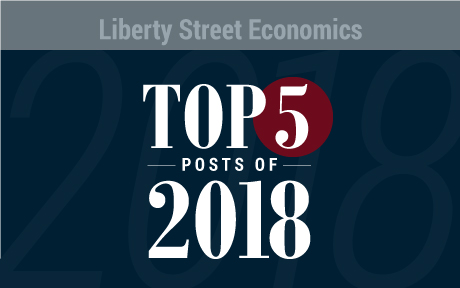What Can We Learn from the Timing of Interbank Payments?

From 2008 to 2014 the Federal Reserve vastly increased the size of its balance sheet, mainly through its large-scale asset purchase programs (LSAPs). The resulting abundance of reserves affected the financial system in a number of ways, including by changing the intraday timing of interbank payments. In this post we show that (1) there appears to be a nonlinear relationship between the amount of reserves in the system and the timing of interbank payments, and (2) with the increase in reserves, smaller banks shifted their timing of payments more significantly than larger banks did. This result suggests that tracking the timing of payments sent by banks could provide an informative signal about the impact of the shrinking Federal Reserve balance sheet on the payments system.
Post‑Crisis Financial Regulation: Experiences from Both Sides of the Atlantic

To celebrate the 100-year anniversary of the Banca d’Italia’s New York office, the Federal Reserve Bank of New York and the Banca d’Italia hosted a workshop on post-crisis financial regulation in November 2018. The goal of the workshop was to discuss differences in regulation between the United States and Europe (and around the globe more broadly), examine gaps in current regulations, identify challenges to be addressed, and raise awareness about the unintended consequences of regulation. The workshop included presentations on such topics as market liquidity, funding, and capital requirements. In this post, we present some of the findings and discussions from the workshop.
The Indirect Costs of Lehman’s Bankruptcy

In our previous post, we assessed losses to customers and clients from foregone opportunities after Lehman Brothers filed for bankruptcy in September 2008. In this post, we examine losses to Lehman and its investors in anticipation of bankruptcy. For example, if bankruptcy is expected, Lehman’s earnings may decline as customers close their accounts or certain securities (such as derivatives) to which Lehman is a counterparty may lose value. We estimate these losses by analyzing Lehman’s earnings and stock, bond, and credit default swap (CDS) prices.
Customer and Employee Losses in Lehman’s Bankruptcy

In our second post on the Lehman bankruptcy [link to recovery blog], we discussed the cost to Lehman’s creditors from having their funds tied up in bankruptcy proceedings. In this post, we focus on losses to Lehman’s customers and employees from the destruction of firm-specific assets that could not be deployed as productively with another firm. Our conclusions are based in part on what happened after bankruptcy—whether, for example, customer accounts moved to other firms or employees found jobs elsewhere. While these indirect costs are difficult to pin down, the analysis suggests that the most notable losses were borne by mutual funds that relied on Lehman’s specialized brokerage advice and firms that used Lehman for its equity underwriting services.
Lehman’s Bankruptcy Expenses

In bankruptcy, firms incur expenses for services provided by lawyers, accountants, and other professionals. Such expenses can be quite high, especially for complex resolutions. The direct costs of bankruptcy proceedings reduce a firm’s value below its fundamental level, thus constituting a “deadweight loss.” Bankruptcy also carries indirect costs, such as the loss in value of assets trapped in bankruptcy—a subject discussed in our previous post (link). In this post, we provide the first comprehensive estimates of the direct costs of resolving Lehman Brothers’ holding company (LBHI) and its affiliates under Chapter 11 bankruptcy, and of Lehman’s broker-dealer (LBI) under the Securities Investor Protection Act (SIPA).
Creditor Recovery in Lehman’s Bankruptcy

Expectations of creditor recovery were low when the Lehman Brothers bankruptcy process started. On the day the firm filed for bankruptcy in September 2008, the average price of Lehman’s senior bonds implied a recovery rate of about 30 percent for senior creditors. A month later the bond price was implying a recovery rate of 9 percent, consistent with results from Lehman’s CDS auction. Two and a half years later, Lehman’s estate estimated that the recovery rate for holding company creditors would be just 16 percent. So, ten years after the filing, how much did creditors actually recover?
How Much Value Was Destroyed by the Lehman Bankruptcy?

Lehman Brothers Holdings Inc. (LBHI) filed for Chapter 11 bankruptcy protection on September 15, 2008, initiating one of the largest and most complex bankruptcy proceedings in history. Recovery prospects for creditors, who submitted about $1.2 trillion of claims against the Lehman estate, were quite bleak. This week, we will publish a series of four posts that provide an assessment of the value lost to Lehman, its creditors, and other stakeholders now that the bankruptcy proceedings are winding down. Where appropriate, we also consider the liquidation of Lehman’s investment banking affiliate (which occurred on a separate track in the Securities Investor Protection Act (SIPA) proceedings).
Coming to Terms with Operational Risk

The term “operational risk” often evokes images of catastrophic events like hurricanes and earthquakes. For financial institutions, however, operational risk has a broader scope, encompassing losses related to fraud, rogue trading, product misrepresentation, computer and system failures, and cyberattacks, among other things. In this blog post, we discuss how operational risk has come into greater focus over the past two decades—to the point that it now accounts for more than a quarter of financial institutions’ regulatory capital.
Cryptocurrencies, Tariffs, “Too Big to Fail,” and Other Top LSE Posts of 2018

“Cryptocurrency” hit the cultural mainstream in 2018. In March, Merriam-Webster added “cryptocurrency” to the dictionary, and in what was perhaps a greater litmus test of pop culture recognition, “bitcoin” was added to the official Scrabble dictionary in September. With such a surge in interest, it’s not too surprising that the most viewed post on Liberty Street Economics this past year focused on an issue surrounding how digital currencies operate that is not often put in the spotlight—trust. Similarly, as the subject of tariffs has become a more frequent topic of discussion in the news, readers have sought additional info, which fueled interest in another of our most viewed posts of the year. As 2019 approaches, we offer a chance to revisit these posts and the rest of our top five of 2018.
Liquidity Effects of Post‑Crisis Regulatory Reform

The post-crisis regulatory reform efforts to improve capital and liquidity positions of regulated institutions provide incentives for banks to change not only the structure of their own balance sheets but also how they interact with their customers and other market participants more generally. A 2015 PwC study on global financial market liquidity, for example, noted that “[a]s banks respond to the new regulatory environment, they have sought to make more efficient use of capital and liquidity resources, by reducing the markets they serve and streamlining their operations.” In this blog post, we provide an overview of three recent New York Fed staff reports that study the impact that post-crisis regulation has had on the willingness and ability of regulated firms to participate in U.S. over-the-counter (OTC) markets.










 RSS Feed
RSS Feed Follow Liberty Street Economics
Follow Liberty Street Economics